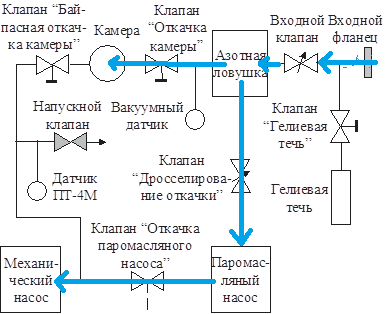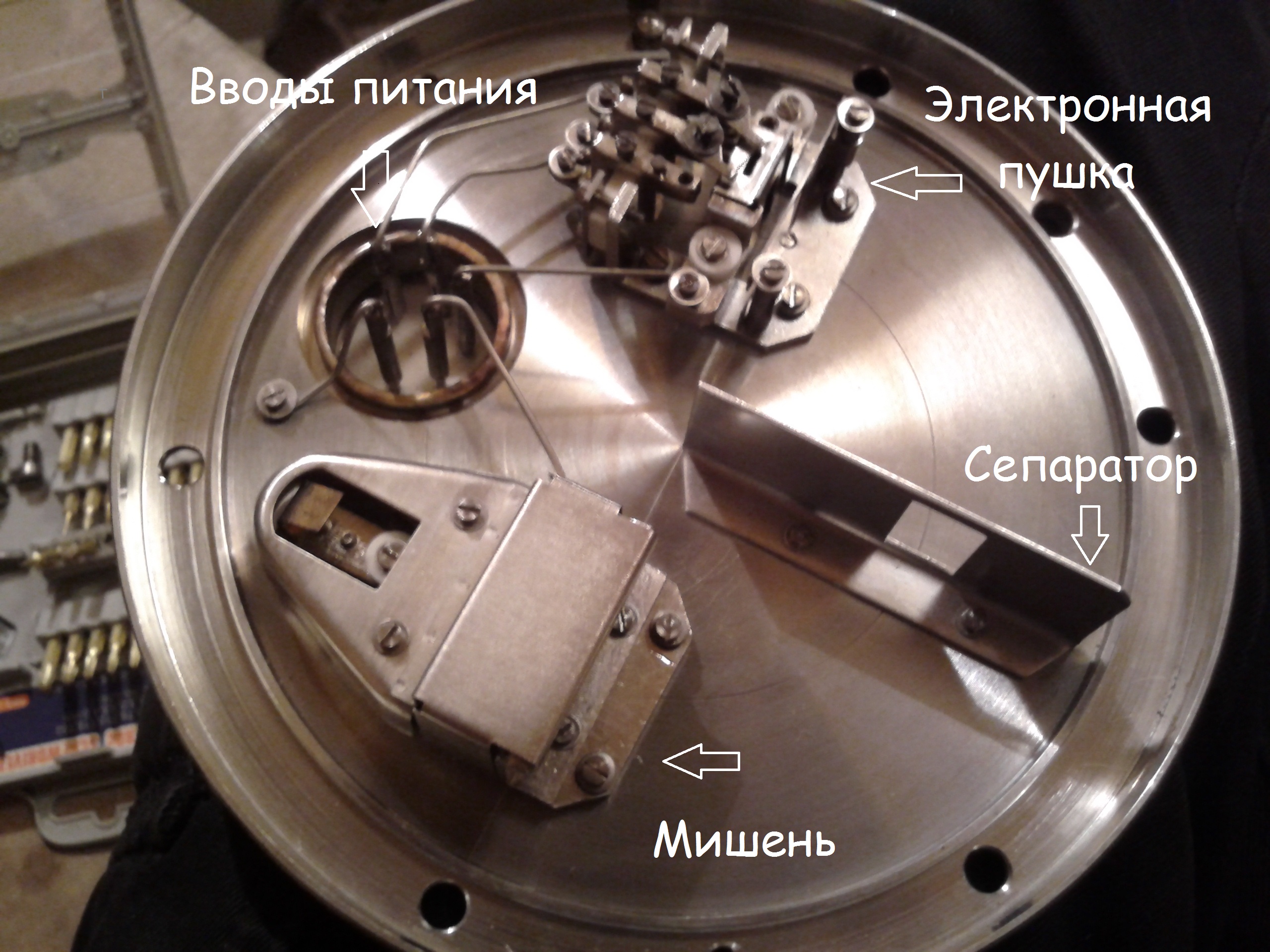Mass spectrometric leak detector PTI-10

Hello. Today I would like to tell you about a wonderful profession - a vacuum cleaner. We will also get acquainted with a very curious and complex device intended for the localization of micro-leaks.
The helium mass spectrometric leak detector PTI-10 is designed to test for leaktightness of various systems and objects that allow pumping of the internal cavity (vacuum), as well as those filled with pure helium or an air-gas mixture containing helium.
By systems is meant, for example, a vacuum jacket of a cryogenic pipeline, a vacuum chamber for testing spacecraft, or a spraying installation.
The PTI-10 leak detector is a universal instrument designed for all types of leak testing, using helium as a test gas. (Why helium will be described below)
Since the error in determining the leakage value of this device depends on the directness of the hands of the operator, the geometric shapes of the object under study, pumping means, humidity or temperature, it is not standardized.
')
In order to understand why it is necessary to fence a cabinet on wheels to search for leaks, consider the dimension of the measured values.
Specifications:
The minimum recorded helium flow without throttling is no more than 1 * 10 -11 m 3 Pa / s , and with choking - 6.6 * 10 -13 m 3 Pa / s.
By choking is meant reducing the pumping speed of the mass spectrometer chamber for accumulating test gas in the analyzer.
A flow of 1 m 3 * Pa / s means that in a volume of 1 m 3 per 1 s, the pressure changes by 1 Pa, and in our case at 1 * 10 -11 m 3 Pa / s.
Calculate how much it is:
1 m 3 = 100cm * 100cm * 100cm = 1000000 cm 3
P = 100000 Pa (atmospheric pressure in pascals)
This means that with a pressure of 1 atmosphere of 1 Pa in 1 m ^ 3 it will occupy by volume fraction 1000000 \ 100000 = 10 cm 3 , but we do not have whole Pascal, but 1 * 10 -11 therefore 1 * 10 -11 * 10 cm 3 = 1 * 10 -10 cm 3 .
It is worth remembering that the measurement is made even in seconds, that is, such a small volume also flows in a second. How can it be recorded and measured?
The answer is simple and complex at the same time. On the one hand, the principle is to reduce the density of other gases (the “heavier” the gas, the easier it is to pump it out) and the exact direction of the helium ions into the analyzer (mass spectrometer target), and on the other hand, the implementation is complex and contains a fair amount of subtle stones.
Let's start with the analysis of the principle of work.
In order to understand whether an object is sealed, an object is pumped with helium and placed in an industrial vacuum chamber, for example, such or household use .

Or vacuum the sample (if possible) and blow it with a stream of helium. In any case, in the presence of leaks, helium enters the pumping system consisting of a cascade of various vacuum pumps.
Here, finally, samples of test gas at the entrance to the leak detector, what happens next? And nothing, because you first need to open the inlet valve and smoothly equalize the pressure in the leak detector and the exhaust pipe. If it is opened too quickly, and the vacuum in the nozzle is noticeably worse than in the leak detector, the nitrogen trap boils and the mass spectrometer chamber temporarily fails. But about everything in order.
Remove the back cover and look inside.

In schematic form, it looks like this.

The residual atmosphere from the object under study passes the inlet flange and ends up in a nitrogen trap, where residual water vapors are frozen out of a vacuum (they are almost always).
Nitrogen trap is the place of contact between vacuum and cryogenic temperatures (usually a sealed container into which a flask is welded for pouring cryogenic liquid)

After that, helium basically goes to the steam-oil pump (since there is a better vacuum, which means the pressure is a little, but less).
The steam-oil vacuum pump pumps out the atmosphere with a supersonic jet of red-hot oil vapor, capturing and not releasing.

P then in the rotary vane pump and on the street:
The rotary vane pump seizes and compresses the residual atmosphere by rotating it by squeezing it out.

But the rest of the helium gets into the mass spectrometer. This is where the fun begins.
Mass spectrometry in PTI-10 assumes the presence of a charge carrier and the ratio of the mass to the charge of ions resulting from the ionization of the test gas. Helium is the test gas, since its primary ionization energy is low and its natural abundance in the atmosphere tends to zero.
Consider a mass spectrometer chamber

As you can see, there are only 3 functional elements here, but each of them is cunning and dangerous.
The electron gun is a small accelerator of charged particles (sorry for the quality, there are no other samples of the photo).

From above, a tungsten cathode is installed on the slit, which heats up to 700-1000 during operation; when heated to such a temperature, it forms around itself a stream of electrons partially falling into the slit. Under the slit there is an electron gun chamber, in which the mystery of impact ionization of the helium atom by an electron takes place (others, too, but to a lesser extent).

Cathodes
Well, we ionized helium - what's next?
Then it accelerates through the “muzzle” of the gun with a potential difference of up to 400 V (the cathode is a camera, and the anode is the frame in front of the camera) and flies out of the electron gun.
Now, in theory, he should fly forward and ingloriously die crashing against the wall, but he is saved by the guiding magnetic system of the mass spectrometer. More precisely, it is saved by the power of Lorentz , forcing him to move in an arc to the separator.
The separator is a metal plate with a rectangular hole located on the calculated arc of the movement of the helium ion. It turns out that only helium flies through the hole in the separator (the rest because of the greater mass do not have time to turn and die).
Sometimes the magnetic system gets off and you have to make an adjustment, changing its position relative to the camera of the mass spectrometer and thus directing the flow of ions.
Further, the ion enters the target, creates an ionic current, is amplified by tube and transistor cascades and is displayed on a voltmeter in the head display unit (there are also blocks that control valves, camera power, pressure display in different parts of the system).
Do not worry, we work not only by Soviet samples (they are simply not killed and are being repaired on the go), Here, for example, is a sample of one St. Petersburg office.

Everything is automated (fool protection admires) and a convenient display system has been added (sorry for the quality, working without light).

Instead of a steam-oil pump there lives a turbomolecular one .

Ask and correct, if necessary, supplement the article photo.
Source: https://habr.com/ru/post/366091/
All Articles